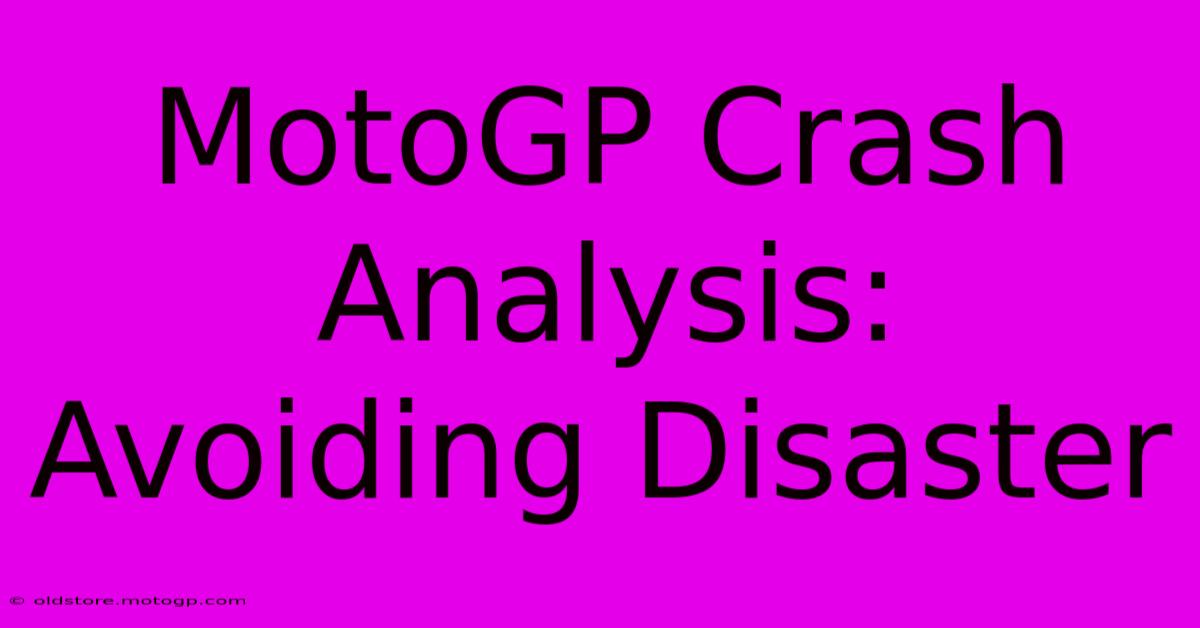MotoGP Crash Analysis: Avoiding Disaster

Table of Contents
MotoGP Crash Analysis: Avoiding Disaster
MotoGP racing, a spectacle of speed, skill, and breathtaking maneuvers, unfortunately, also features its share of crashes. Understanding why these crashes occur is crucial, not only for improving rider safety but also for enhancing the overall excitement and competitiveness of the sport. This in-depth analysis delves into the common causes of MotoGP crashes, exploring preventative measures and technological advancements aimed at minimizing risk.
Understanding the Dynamics of MotoGP Crashes
MotoGP crashes are rarely single-cause events. Instead, they often result from a complex interplay of factors, including:
1. Rider Error: The Human Factor
Let's face it; even the world's best riders are human. Rider error accounts for a significant portion of MotoGP crashes. This includes:
- Pushing too hard: The relentless pursuit of speed and lap records often leads riders to exceed the limits of both themselves and their machines. Overdriving, especially in challenging conditions, significantly increases the risk of a fall.
- Loss of concentration: Maintaining focus for an entire race, amidst intense pressure and high speeds, is incredibly demanding. Even a momentary lapse in concentration can be catastrophic.
- Incorrect line choices: Choosing the wrong racing line, particularly through corners, can lead to loss of control and a subsequent crash. This is particularly relevant when considering the extreme lean angles involved in MotoGP.
- Poor braking techniques: Incorrect braking points or techniques can easily lock up wheels, leading to a loss of traction and a subsequent fall.
2. Mechanical Failures: The Machine's Role
While riders are responsible for a large percentage of crashes, mechanical failures also play a part. These can include:
- Tire failures: Tire punctures or loss of grip due to wear and tear, especially in demanding conditions like rain, can result in immediate loss of control.
- Brake failure: A sudden loss of braking power, especially mid-corner, is a recipe for disaster. Regular maintenance and meticulous checks are paramount.
- Engine failures: While less common, engine seizures or other mechanical problems can cause a rider to lose control unexpectedly.
- Chassis issues: Issues with the motorcycle's frame or suspension can impact stability and handling, increasing the likelihood of a crash.
3. External Factors: Beyond Rider and Machine
- Track conditions: Wet or oily tracks significantly reduce grip, making crashes much more likely. Changes in track surface, such as debris or oil spills, can also be hazardous.
- Other riders: Collisions with other riders are a frequent cause of crashes, often resulting from aggressive overtaking maneuvers or racing incidents.
- Weather conditions: Sudden changes in weather, particularly rain showers, can drastically alter track conditions and catch riders off guard.
Minimizing Risk: Prevention and Technology
The MotoGP community is continuously striving to improve safety. This involves a multi-pronged approach:
1. Rider Training and Skill Development
Rigorous training programs focus on developing riders' skills in areas such as:
- Smoothness and control: Learning to ride smoothly and maintain control at the limits of traction is crucial.
- Brake control: Mastering braking techniques and understanding the nuances of braking under different conditions.
- Racecraft: Developing the ability to race strategically and make informed decisions on the track.
2. Technological Advancements
Significant advances in technology are continuously improving safety:
- Improved safety equipment: Advanced leathers, helmets, and airbag systems offer better protection in the event of a crash.
- Motorcycle advancements: Improvements in chassis design, electronics, and tire technology enhance stability and control.
- Track safety improvements: Run-off areas, air fences, and improved track surfaces are designed to mitigate the impact of crashes.
- Telemetry and data analysis: Analyzing rider data helps identify areas for improvement and helps predict potential issues.
Conclusion: A Continuous Pursuit of Safety
While crashes are an inherent risk in MotoGP, ongoing efforts in rider training, technological advancement, and track safety improvements are continuously reducing the frequency and severity of accidents. By understanding the factors contributing to these crashes, we can appreciate the immense skill of the riders and the dedication of the sport to ensuring the safety of its participants. The pursuit of higher speeds and more exciting racing must always be balanced with a commitment to minimizing risk and improving rider safety.

Thank you for visiting our website wich cover about MotoGP Crash Analysis: Avoiding Disaster. We hope the information provided has been useful to you. Feel free to contact us if you have any questions or need further assistance. See you next time and dont miss to bookmark.
Featured Posts
-
Racing Style Essentials Find Them At The Cota Gift Shop
Feb 20, 2025
-
American Moto Gp Be Part Of History
Feb 20, 2025
-
Cota Track Days The Ultimate Adrenaline Fix
Feb 20, 2025
-
F1 Austin Your Parking Survival Guide
Feb 20, 2025
-
Witness The Power F1 Austin Concert
Feb 20, 2025
